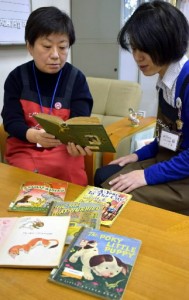Books donated by the U.S. for Hiroshima children after A-bombing are listed in new booklet
Mar. 18, 2016
by Minako Okuda, Staff Writer
A booklet listing the “Bell Collection,” a collection of English books for children, is now being created. With the aim of revitalizing the cultural life of the A-bombed city, the books were donated by the United States to the City of Hiroshima in 1949. The city’s Children’s Library, located in Naka Ward, currently holds the collection and the staff began compiling the information last summer, which marked the 70th anniversary of the atomic bombing. A presentation about the collection will take place at the Central Library, also in Naka Ward, on March 5 at 10 a.m.
The collection at the Children’s Library is comprised of 714 books, including picture books and novels, published in the 1930s and 1940s. This constitutes part of the roughly 1,500 books donated by American families through the late Howard Mitchel Bell (1897-1960), a former staff member of the Civil Information and Education Section (CIE) of the General Headquarters of the Allied Forces (GHQ).
The book donation enabled the Children’s Library to open in 1949. Although the collection is considered valuable material for understanding the culture and trends of the United States back then, the content and value of the books had not been fully explored.
The booklet, an annotated bibliography, will look at 100 books from the collection, offering detailed information on each, such as the storyline, prominent features, and its popularity in the United States. Okiko Miyake, a professor emeritus at Baika Women’s University in the city of Ibaraki, Osaka and an expert on American and British children’s literature, carried out research at the library last year and wrote the explanations.
Ms. Miyake said, “Because the future of the children of Hiroshima was in mind when these books were donated, it makes us aware of the kindness of the American people at that time. I find the collection very interesting because a variety of books, which must have been frequently read in homes and at schools, are still maintained to this day.”
(Originally published on March 2, 2016)
A booklet listing the “Bell Collection,” a collection of English books for children, is now being created. With the aim of revitalizing the cultural life of the A-bombed city, the books were donated by the United States to the City of Hiroshima in 1949. The city’s Children’s Library, located in Naka Ward, currently holds the collection and the staff began compiling the information last summer, which marked the 70th anniversary of the atomic bombing. A presentation about the collection will take place at the Central Library, also in Naka Ward, on March 5 at 10 a.m.
The collection at the Children’s Library is comprised of 714 books, including picture books and novels, published in the 1930s and 1940s. This constitutes part of the roughly 1,500 books donated by American families through the late Howard Mitchel Bell (1897-1960), a former staff member of the Civil Information and Education Section (CIE) of the General Headquarters of the Allied Forces (GHQ).
The book donation enabled the Children’s Library to open in 1949. Although the collection is considered valuable material for understanding the culture and trends of the United States back then, the content and value of the books had not been fully explored.
The booklet, an annotated bibliography, will look at 100 books from the collection, offering detailed information on each, such as the storyline, prominent features, and its popularity in the United States. Okiko Miyake, a professor emeritus at Baika Women’s University in the city of Ibaraki, Osaka and an expert on American and British children’s literature, carried out research at the library last year and wrote the explanations.
Ms. Miyake said, “Because the future of the children of Hiroshima was in mind when these books were donated, it makes us aware of the kindness of the American people at that time. I find the collection very interesting because a variety of books, which must have been frequently read in homes and at schools, are still maintained to this day.”
(Originally published on March 2, 2016)








